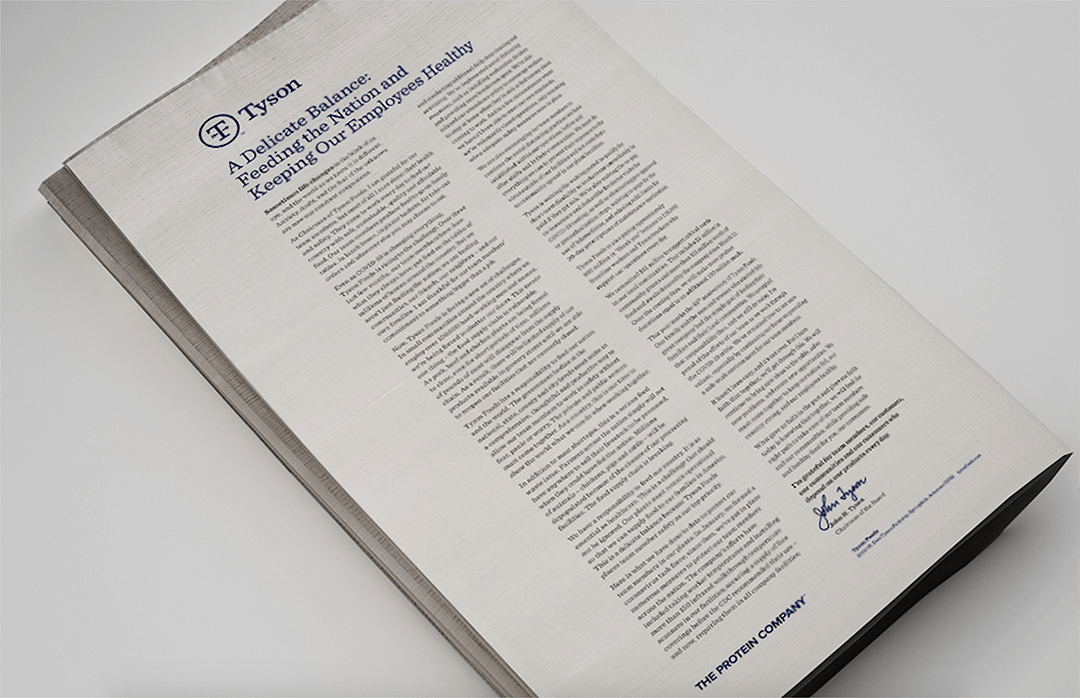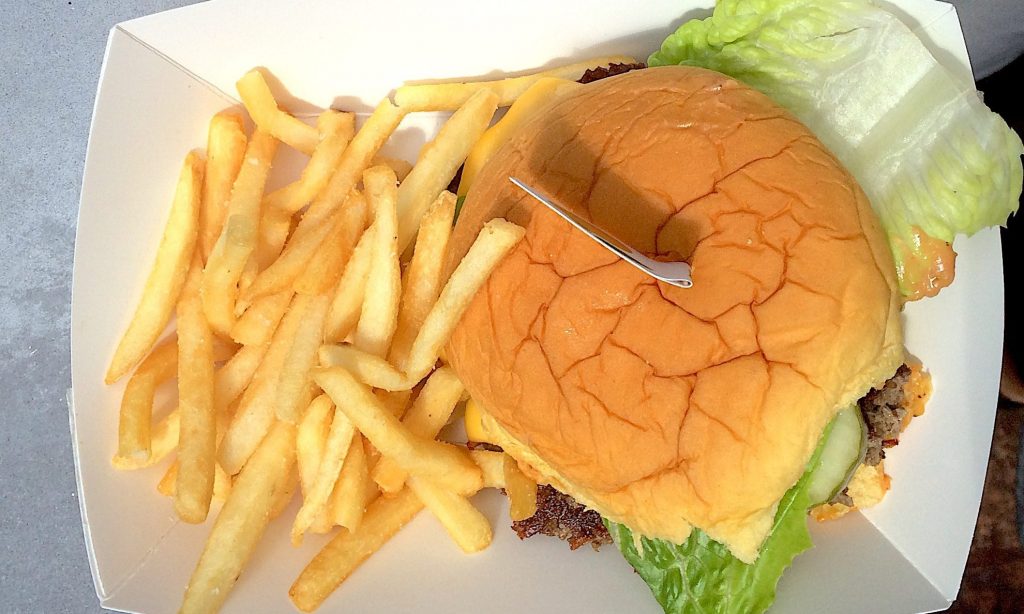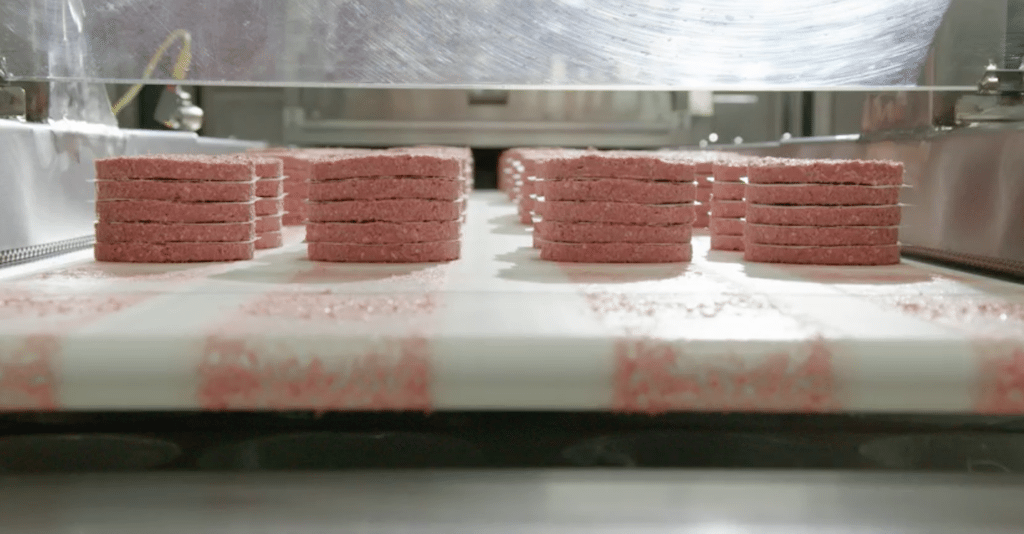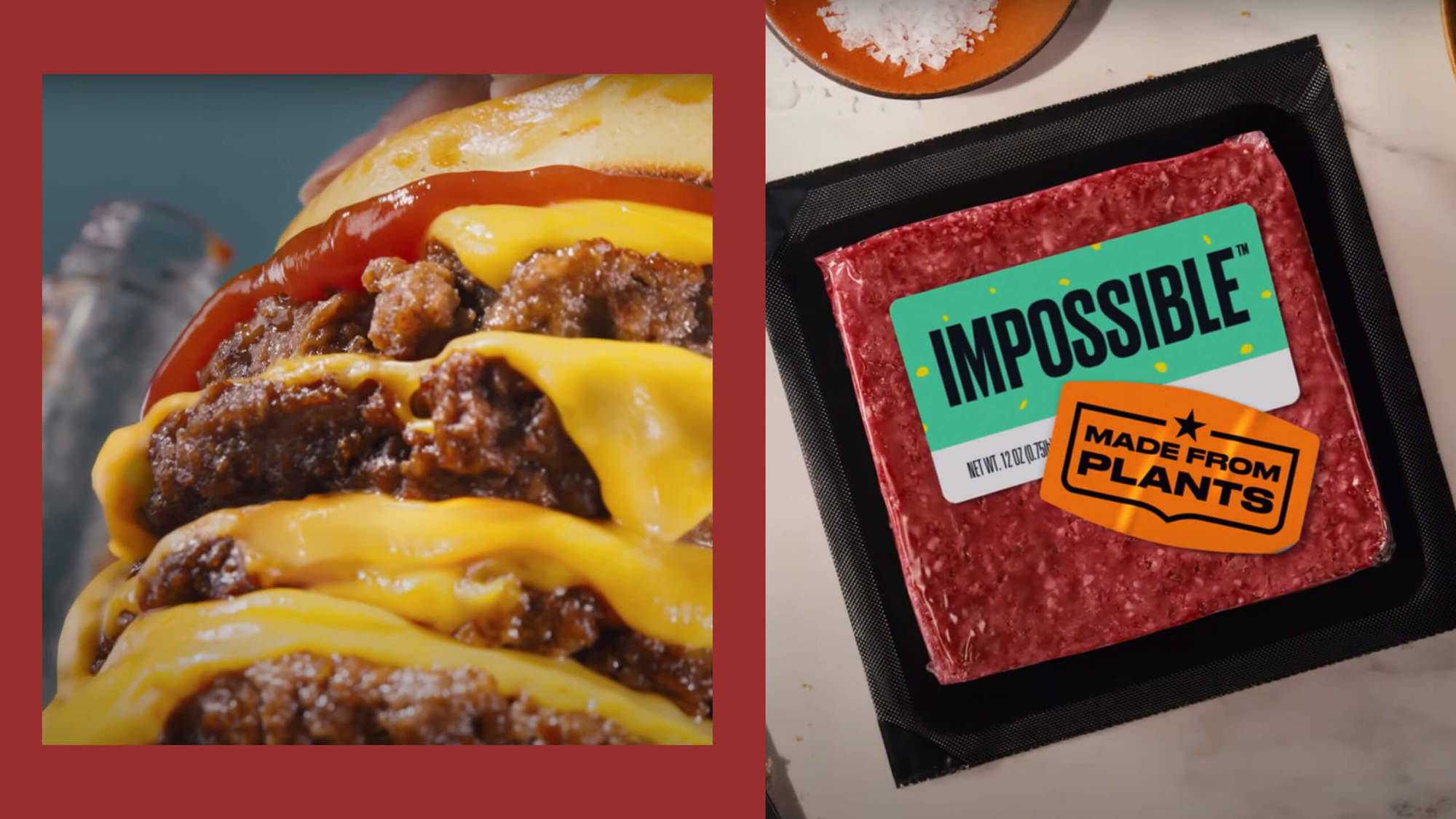
Impossible Foods/ Graphic by Tricia Vuong
The ads aren’t really intended to fool anyone. Their aim is much bolder: to redefine “meat” itself.
The commercial opens with a close-up of a grill: raw pink burger patties sizzling in their fat, some draped with waxy layers of melting American cheese. A spatula flips a fresh slider, and its tender side hits the hot surface in a crackle of grease.
“We love meat,” a gruff, male voice intones. “Red meat. Cooked meat. Bubbly meat. Meat with cheese on it. More meat with cheese on it.”
It’s a recognizable formula, the same brand of burger porn that fast-food chains have beamed into American living rooms for decades. But this incarnation ends with a subversive twist: A kitchen timer dings, and the camera cuts to a package of Impossible Foods ground “beef.” A hand slaps down a “made from plants” decal. Turns out, everything we’ve just seen is vegan.
The ad is one of three in Impossible Foods’ first national TV campaign, “We Are Meat,” which was designed by the creative agency Wieden+Kennedy and began airing across the country this month. The other two commercials revel in the same hedonistic, flame-broiled imagery, playing to our presumed carnivorous instincts before tearing back the curtain: The “meat” you just ogled was actually made from plants.
On a superficial level, the point is obvious. Impossible is bragging about the hyper-realism of its imitation ground beef—made from processed soy protein, coconut oil, and other plant-derived ingredients—which looks and tastes much like the real thing, according to fans and boosters. These veggie burgers are so lifelike, the ads suggest, that you could slip them into a Big Mac and no one would know.
But there’s more here than a simple sleight-of-hand, the flex of briefly fooling viewers into thinking they’re looking at animal meat. If you listen closely, Impossible’s ads suggest something even more provocative: that the company’s products actually are meat. Not fake meat. Not a plant-based alternative. But meat.
“You’ll find this meat wherever you’d buy meat,” the campaign’s drawling narrator says, in a second ad, over another tight shot of patties browning on a flat-top grill. “Like the meat aisle, meat shop, meat store, so many meat places.”
This overt application of the word “meat” to a plant-based burger isn’t just semantically vexing. It brings up questions about what words can be used in advertising and on packaging to describe protein products that increasingly blur boundaries—a conundrum that existing legal and regulatory frameworks never fully anticipated.
On one level, the claim “you’ll find this meat wherever you’d buy meat” merely publicizes the fact that you can now buy Impossible’s ground beef at grocery stores nationwide, maybe even in the fresh meat case. That wasn’t necessarily true before the pandemic, when next-generation veggie burger companies like Impossible and Beyond Meat still relied heavily on restaurants—especially fast-food chains—to get their products into customers’ stomachs. According to a recent blog post by Impossible Foods president Dennis Woodside, the company was only in 150 grocery stores in February 2020. Now, a little over a year later, the company reports that it’s in more than 17,000 stores—an astonishing hundred-fold increase that can be attributed both to temporary supply chain disruptions in meatpacking and Impossible’s rapidly expanding production capacity.
Still, that impressive growth is overshadowed by the ad’s central assertion: that the Impossible Burger genuinely qualifies as meat. After all, in the sentence “you’ll find this meat wherever you’d buy meat,” there’s no plant-based modifier to be found.
The ads bring up questions about the words we use to describe protein products that blur traditional categories.
Just to make sure I wasn’t misunderstanding, I asked Rachel Konrad, Impossible’s chief communications officer: Does the company really feel that the Impossible Burger qualifies as “meat”—period, full stop? Her answer was unequivocal.
“Yes, we do,” she said. “Anatomically, molecule for molecule, our product—and our product uniquely—has the secret sauce of what makes meat meat.”
She’s referring specifically to soy leghemoglobin, or “heme,” the company’s soy-derived approximation of hemoglobin, or the stuff that makes blood red. Heme is what gives Impossible’s plant-based ground beef its famous ability to “bleed” like a medium-rare burger. It’s a prized piece of intellectual property and is the company’s secret weapon—one that took years and many millions of dollars to develop, and is currently the source of more than 250 pending patents, according to Konrad.
“Any part of you that needs to carry oxygen, like your muscle, requires a lot of heme,” she said. “Because [heme] is ubiquitous, though—because it’s found in every living thing, including plants—there are ways that we can get heme from natural, plant-based sources. If we add that to a convincing analogue of a ground beef burger, then, hey, we’ve got the salient secret sauce to meat itself. So functionally, molecularly, this is meat.”
It’s a compelling argument. If a food looks just like meat at the molecular level—a claim The Counter can’t independently confirm, by the way—can’t it simply be called “meat,” regardless of its origin?
“Small disclaimers at the end of an ad aren’t generally sufficient to change the net impression of all of the hoopla going on.”
That’s where it gets complicated—at least legally speaking. In 1983, the Federal Trade Commission (FTC), the federal agency that oversees advertising, outlined its framework for deceptive marketing in a so-called “Deception Statement.” According to that memo, an ad can be considered deceptive if it contains a material omission or misrepresentation that is likely to mislead a “reasonable consumer” to their detriment.
On its own, the statement “buy this meat wherever you’d buy meat” wouldn’t appear to pass that test: A reasonable consumer would have to assume the company was referring to, well, “meat”—as traditionally defined.
Of course, Impossible does include the prominent “made from plants” disclaimer at the end of the ad. It doesn’t let the term “meat” stand on its own for long. And because the product being advertised, “Impossible Meat,” is introduced in the same breath as “made from plants” in the ad’s final moments, it’s unlikely that reasonable customers would confuse Impossible for a traditional burger company.
Still, for plant-based companies that really want to claim the “meat” mantle, throwing in short, revealing disclaimers at the end of an ad may not always fly.
“We don’t think that consumers actually analyze and visually process every word that’s in an advertisement,” said Richard Cleland, assistant director of FTC’s division of advertising policies. “Consumers, when they’re looking at an ad, are creating a net impression of the whole thing. And what they’re going to focus on is what’s pushed up to them in the ad. So small disclaimers at an end of the ad aren’t generally sufficient to change the net impression of the headlines and all of the hoopla that’s going on. If the information in a disclaimer is inconsistent with the main message of the ad, consumers will reject or ignore the information in the disclosure.”
To be clear, Cleland is not referring specifically to Impossible’s latest ad campaign (he didn’t recall ever seeing it). And I’m not saying the ads are indeed deceptive—I think they’re more provocative than misleading. But this does mean that if plant-based companies continue building on the strategy used in “We Are Meat,” playing up “meat” terminology throughout their ads with only a brief disclaimer at the end, they could fall afoul of FTC.
That said, FTC isn’t looking actively at the nuances of naming alt-meat products on-air, at least for now. Historically, as outlined in a 1994 memorandum of understanding, the commission primarily focuses on two categories when it comes to food marketing: nutrient content claims and health benefit claims. But calling a plant-based burger “meat” doesn’t mislead anyone about specific nutrients in a product, and doesn’t make any promises about the way a product can benefit a person’s body or mind.
While there is no federal law or regulation that specifically lays out naming requirements for plant-based meat analogues, companies like Impossible are still subject to the same rules other food companies are.
In order for FTC to take a more active role in meatless meat debate, there would likely have to be interest from its partner in regulating food marketing: the Food and Drug Administration (FDA), the federal agency that oversees food packaging claims, among other things. FTC has a long-standing principle of deferring to FDA principles when an advertisement includes FDA-regulated claims.
For now, though, FDA hasn’t issued specific rules about what alternative-protein companies can or can’t say on their packaging, according to Brian Sylvester, a lawyer who advises on food and compliance issues for the firm Covington and Burling. But while there is no federal law or regulation that specifically lays out naming requirements for plant-based meat analogues, companies like Impossible are still subject to the same rules other food companies are. Per FDA, their labeling must not be false or misleading—a similar standard to what FTC uses to evaluate ads.
In practice, this means plant-based products labeled with words like “meat,” “burger,” and “sausage” must add a qualifier to make clear that they’re really made from plants: “vegan,” “meatless,” and so on. So while Konrad can insist in an interview that Impossible’s product is “meat,” the company can’t use that standalone term on items sold in the grocery store.
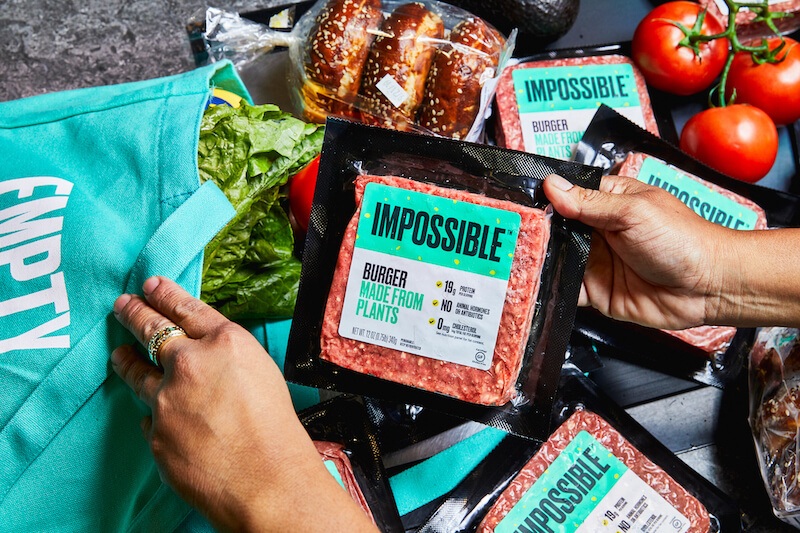
It would likely irk FDA for Impossible Foods to call its product “meat”—no modifier—in the grocery store. But the company doesn’t—and doesn’t want to.
Impossible Foods
In fact, it doesn’t. On its packaging, Impossible uses the word “burger” to describe its product, with “made from plants” appended prominently in the same font size. The package doesn’t use the word “meat” anywhere. The back of the label, though, does say the product contains “no cow” and can be used “like ground beef.” These disclaimers—or are they boasts?—make it hard to argue that a reasonable customer could be fooled into thinking the product actually came from animals.
And yet, it’s unclear whether the specific language used in the “We Are Meat” ads would actually fly if applied to a piece of packaging—a consideration that’s relevant given the close collaboration between FTC and FDA.
I asked FDA whether the phrase “buy this meat wherever you’d buy meat” would be allowed on a box of store-bought veggie burgers. The agency declined to answer, saying it doesn’t comment on individual instances of packaging. But an agency spokesperson did say that FDA evaluates claims and terms “on a case-by-case basis in the context of the entire label, and not in isolation.”
Given the absence of specific rules to govern the language of meat alternatives, I take this to mean that anything is potentially “sayable,” if it’s hedged enough. The overall presentation just has to pass FDA’s gut check: Taken together, the impression can’t be that the product is claiming to be something it isn’t. (This rubric is not unlike former U.S Supreme Court Justice Potter Stewart’s infamous definition of pornography—FDA knows label fraud when it sees it.)
Alt-protein companies want to convince us that their “meat” is identical to animal flesh when it comes to taste and texture. But they also want to underscore their products’ significant differences.
That framework is fuzzy and lacks transparency, basically amounting to a common-sense test. Yet Impossible’s new ads clearly pass that test. Yes, you’re briefly fooled into thinking you’re looking at meat, as traditionally defined. But the surprise ending changes all that: If the revelation of Impossible’s now-famous brand name doesn’t set you straight, the unambiguous “made from plants” language will.
That’s why the recent rash of meat-industry-support state laws aimed at regulating what can be said on plant-based packages kind of miss the point. Those laws, which have passed in Arkansas, Louisiana, Missouri, Mississippi, Montana, South Dakota, and Wyoming start from the same premise: Using a word like “bacon” or “sausage” on a plant-based product without also adding a term like “vegan” is likely to mislead people. In Arkansas and Louisiana, the laws go even further: Plant-based companies can’t use the term “meat” on their labels, period, no matter what qualifiers are added—a legal position that is currently being challenged in court as a violation of alt-protein companies’ First Amendment rights.
Ostensibly, these rules protect consumers from being hornswoggled into buying plant-based meat by mistake. (Critics say the laws are more likely intended to protect the meat industry’s home turf.) But rigid prohibitions miss the real dynamic at play here. While companies like Impossible want to convince us that their “meat” is identical to animal flesh when it comes to taste and texture and appearance, they also very much want to underscore their products’ significant differences. They don’t want the illusion to be total. That would mean giving up their primary competitive advantage: the fact that alt-meat comes to you slaughter-free.
This fundamental duality pervades all Impossible’s marketing, Konrad acknowledges. The company wants us to believe that its product is literally meat—just not meat as we grew up knowing it.
The “We Are Meat” campaign isn’t trying to fool you into thinking the Impossible Burger is meat. It’s trying to convince you that it is.
“We’ve got the taste, the sizzle, the juiciness, all of that kind of stuff [we typically associate with meat],” she said. “Yet at the same time, we do not have the obvious known downsides of ground beef from cows, which [are] cholesterol, hormones, trans fats, gristle, knuckle—the fact that it’s produced from the ground-up carcass of a mammal. We don’t have any of that.”
The “We Are Meat” campaign, then, isn’t trying to fool you into thinking that the Impossible Burger is meat. It’s trying to convince you that it is. That’s a subtle distinction, but it matters. Instead of merely trying to pass off alt-meat as “real,” the company is asking us to expand our sense of what “meat” can be. It’s putting the product’s striking contradiction—“meat, made from plants”—front and center, and asking us to ponder whether it’s really such a contradiction after all.
It’s a brazen, provocative strategy, and one that’s uniquely well-suited to TV. Food packaging labels are static, in the end: Potential customers size them up all at once, with all the necessary hedging present right up front. But commercials tell a story with a beginning, middle, and end. That structure provides an opportunity to start with an assumption and a visual trick, and end with a potentially radical message or realignment of what we think we know. That shapeshifting potential befits an offering like the Impossible Burger, which is many things at once.
Konrad assures me that “We Are Meat” is just an opening salvo—there’s much more coming in this vein. In case there was any doubt of that, Impossible has just hired Steve Turner, a former chief creative officer of Apple, as its “chief experience officer.” Turner led Apple’s in-house branding agency, and one of his first accomplishments was working closely with Steve Jobs to market the first iPhones. That was 15 years ago, when the idea of operating a device by touchscreen still seemed radically new, and “meat” and “plants” were still definitionally distinct categories, as it seemed they would always be.


